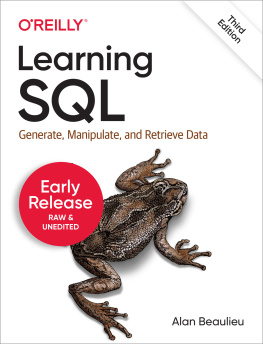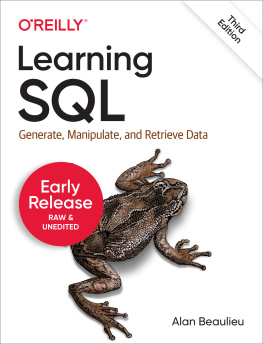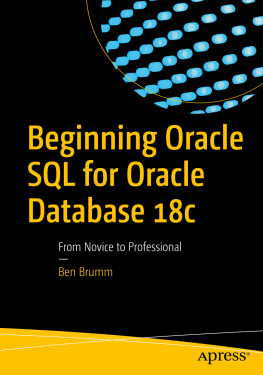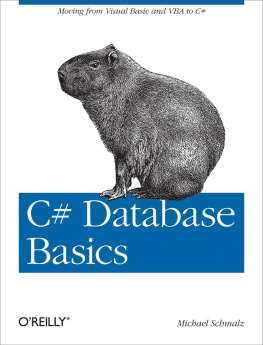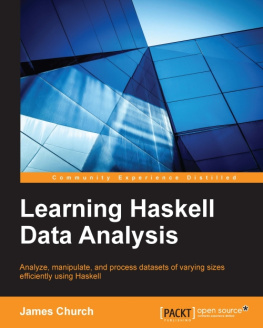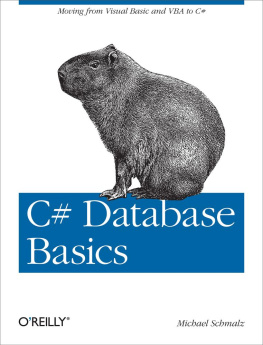Learning SQL
by Alan Beaulieu
Copyright 2020 Alan Beaulieu. All rights reserved.
Printed in the United States of America.
Published by OReilly Media, Inc. , 1005 Gravenstein Highway North, Sebastopol, CA 95472.
OReilly books may be purchased for educational, business, or sales promotional use. Online editions are also available for most titles (http://oreilly.com/safari). For more information, contact our corporate/institutional sales department: 800-998-9938 or corporate@oreilly.com .
- Acquisitions Editor: Jessica Haberman
- Development Editor: Jeff Bleiel
- Production Editor: Deborah Baker
- Interior Designer: David Futato
- Cover Designer: Karen Montgomery
- Illustrator: Rebecca Demarest
Revision History for the Early Release
- 2019-12-11: First Release
See http://oreilly.com/catalog/errata.csp?isbn=9781492057611 for release details.
The OReilly logo is a registered trademark of OReilly Media, Inc. Learning SQL, the cover image, and related trade dress are trademarks of OReilly Media, Inc.
The views expressed in this work are those of the author, and do not represent the publishers views. While the publisher and the author have used good faith efforts to ensure that the information and instructions contained in this work are accurate, the publisher and the author disclaim all responsibility for errors or omissions, including without limitation responsibility for damages resulting from the use of or reliance on this work. Use of the information and instructions contained in this work is at your own risk. If any code samples or other technology this work contains or describes is subject to open source licenses or the intellectual property rights of others, it is your responsibility to ensure that your use thereof complies with such licenses and/or rights.
978-1-492-05754-3
[LSI]
Preface
Programming languages come and go constantly, and very few languages in use today have roots going back more than a decade or so. Some examples are Cobol, which is still used quite heavily in mainframe environments, and C, which is still quite popular for operating system and server development and for embedded systems. In the database arena, we have SQL, whose roots go all the way back to the 1970s.
SQL is the language for generating, manipulating, and retrieving data from a relational database. One of the reasons for the popularity of relational databases is that properly designed relational databases can handle huge amounts of data. When working with large data sets, SQL is akin to one of those snazzy digital cameras with the high-power zoom lens in that you can use SQL to look at large sets of data, or you can zoom in on individual rows (or anywhere in between). Other database management systems tend to break down under heavy loads because their focus is too narrow (the zoom lens is stuck on maximum), which is why attempts to dethrone relational databases and SQL have largely failed. Therefore, even though SQL is an old language, it is going to be around for a lot longer and has a bright future in store.
Why Learn SQL?
If you are going to work with a relational database, whether you are writing applications, performing administrative tasks, or generating reports, you will need to know how to interact with the data in your database. Even if you are using a tool that generates SQL for you, such as a reporting tool, there may be times when you need to bypass the automatic generation feature and write your own SQL statements.
Learning SQL has the added benefit of forcing you to confront and understand the data structures used to store information about your organization. As you become comfortable with the tables in your database, you may find yourself proposing modifications or additions to your database schema.
Why Use This Book to Do It?
The SQL language is broken into several categories. Statements used to create database objects (tables, indexes, constraints, etc.) are collectively known as SQL schema statements. The statements used to create, manipulate, and retrieve the data stored in a database are known as the SQL data statements. If you are an administrator, you will be using both SQL schema and SQL data statements. If you are a programmer or report writer, you may only need to use (or be allowed to use) SQL data statements. While this book demonstrates many of the SQL schema statements, the main focus of this book is on programming features.
With only a handful of commands, the SQL data statements look deceptively simple. In my opinion, many of the available SQL books help to foster this notion by only skimming the surface of what is possible with the language. However, if you are going to work with SQL, it behooves you to understand fully the capabilities of the language and how different features can be combined to produce powerful results. I feel that this is the only book that provides detailed coverage of the SQL language without the added benefit of doubling as a door stop (you know, those 1,250-page complete references that tend to gather dust on peoples cubicle shelves).
While the examples in this book run on MySQL, Oracle Database, and SQL Server, I had to pick one of those products to host my sample database and to format the result sets returned by the example queries. Of the three, I chose MySQL because it is freely obtainable, easy to install, and simple to administer. For those readers using a different server, I ask that you download and install MySQL and load the sample database so that you can run the examples and experiment with the data.
Structure of This Book
This book is divided into 15 chapters and 3 appendixes:
, demonstrates how to create a MySQL database, create the tables used for the examples in this book, and populate the tables with data.
, introduces the selectstatement and further demonstrates the most common clauses (select, from, where).
, demonstrates the different types of conditions that can be used in the whereclause of a select, update, or deletestatement.
, explores how conditional logic (i.e., if-then-else) can be utilized in select, insert, update, and deletestatements.

